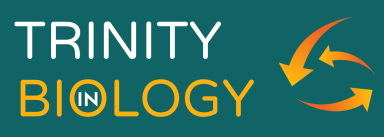THE IMAGE OF THE HOLY TRINITY IN THE CELL
"To be sure God has left trace of his Trinitarian being in his work of creation"
Catechism of the Catholic Church, Paragraph 237
St Augustine's
SCIENTIFIC
PREDICTION
In his book On the Trinity, St Augustine of Hippo claimed that if the universe was created by the Holy Trinity, then there should exist evidence of this within the universe itself, in the form of traces or images of the Trinity. Augustine called these "vestiges" of the Holy Trinity, since he believed they were left over from creation. Augustine never found any vestiges of the Trinity in the natural world. But Augustine wasn't wrong, he was just 1600 years ahead of his time.
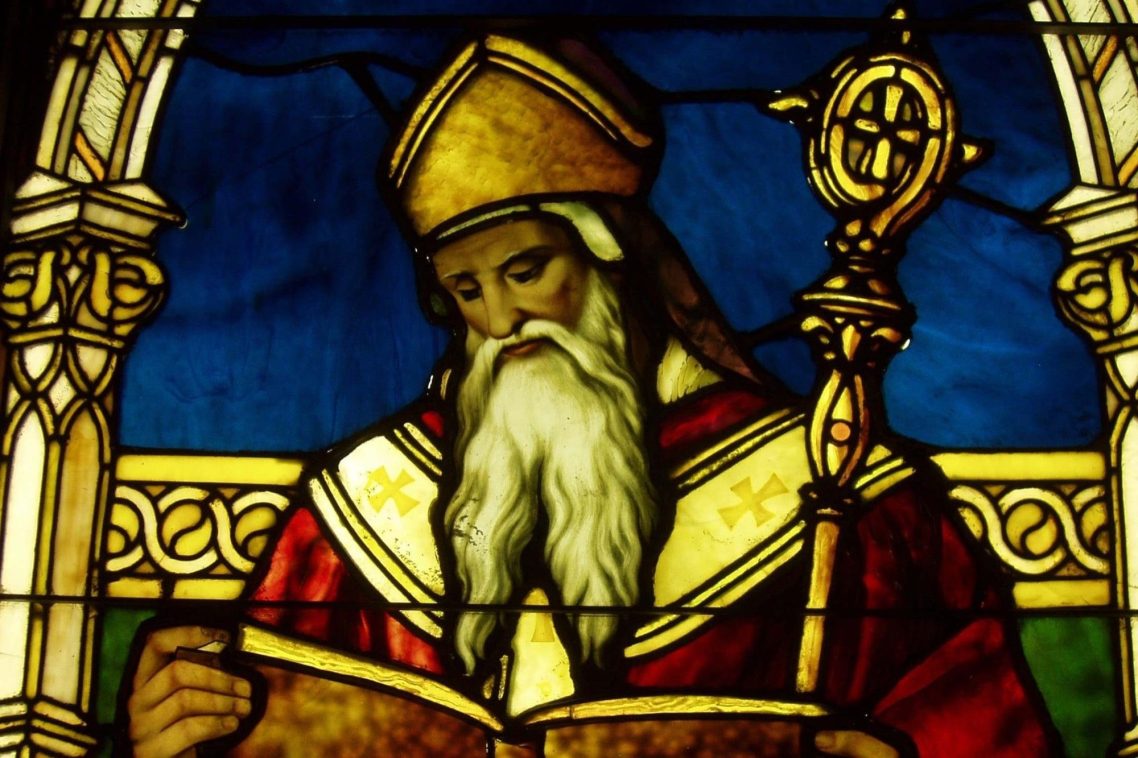
St Augustine of Hippo (d. 430) was one of the most influential theologians in the history of Christianity.
GENESIS PREDICTS
The image of the Holy Trinity in the cell
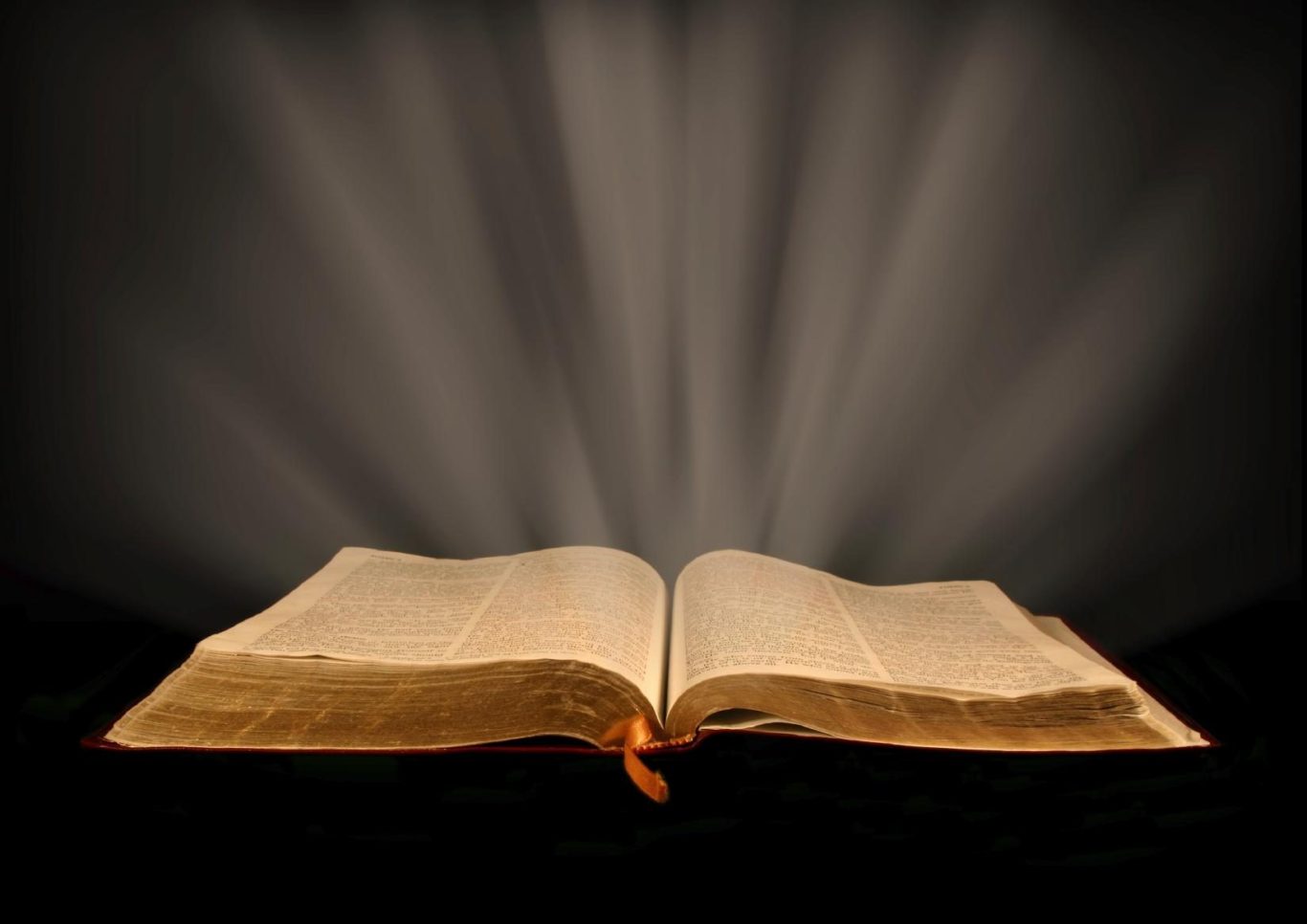
While St Augustine believed vestiges of the Holy Trinity exist in nature, he didn't know where. In contrast, the Bible gives a precise location - on the very first page.
In the first account of Creation in the book of Genesis, God famously says, "Let us make man in our own image, according to our likeness" (Genesis 1:26). Two questions immediately spring from this phrase. Exactly where is the image of God in man? And who is the God speaking these words?
It is traditionally believed that the image of God exists within the human soul. But this leaves out an important part of human beings: the body. Human beings are made from cells, if the image of God is in the whole body then it must be in each, individual cell of the human body.
As to the identity of God, the God talking in Genesis has a unique characteristic: plurality. God says, "Let us make man...in our image", not, "I will make man...in my image". Judaism strictly believes that God is one every respect - there is no way a Jewish writer (such as the one who penned Genesis 1) would even think of portraying God as plural.
The only reason God would speak in the plural is because God is plural. There is only one candidate who fits this description: the God speaking in Genesis is the Holy Trinity. The image of God phrase isn't an incomprehensible mystery as is often believed, it's a scientific claim.
What about other organisms?
Human cells are essentially no different from the cells of any other organism, biologically speaking. If human cells contain the image of the Holy Trinity, then so are the cells of all other organisms. Put simply, human beings are not the only ones made in the image of God, so is every other organism.
If this is true, why then does Genesis only mention human beings (man)? Genesis doesn't need to explicitly state this fact, since we are perfectly capable of figuring it our for ourselves - based on one example alone (the human race). In any case, the book of Genesis would be unnecessarily long if every species under the sun was listed!

Not just human beings but every organism has been made in the image of God. This does not eliminate the religious view that human beings are fundamentally different from all other living beings. What makes human beings different from other organisms is the presence of a spiritual soul, which also has the image of God. So, humans have a double-helping of God's image - in matter and spirit. Whereas all other organisms only have a single-helping, in their material body. If you do not believe in a spiritual soul, chances are, you won't be bothered about the fundamental distinction of the human race.
DNA, RNA, PROTEIN
The image of the Holy Trinity in the cell

The Holy Trinity has two particularly distinguishing characteristics: three and communication. A physical system must satisfy at least these two criteria to be an image of the Holy Trinity.
There are only three molecules which communicate information in the (known) universe: DNA, RNA and protein. There is one place where these three informational macromolecules exist together: living cells. DNA, RNA and protein is the only triadic communication in the natural world.
Nevertheless, this is not conclusive proof that DNA, RNA and protein really are the image of the Holy Trinity. Having said that, there is something else about DNA, RNA and protein which is enough to convince many people: DNA, RNA and protein have exactly the same pattern of names as the three persons of the Holy Trinity. That is, the Father, Son and Holy Spirit. Can you spot the pattern?
Let us know when you spot the pattern!
The image of the Holy Trinity
MAKES PROTEINS
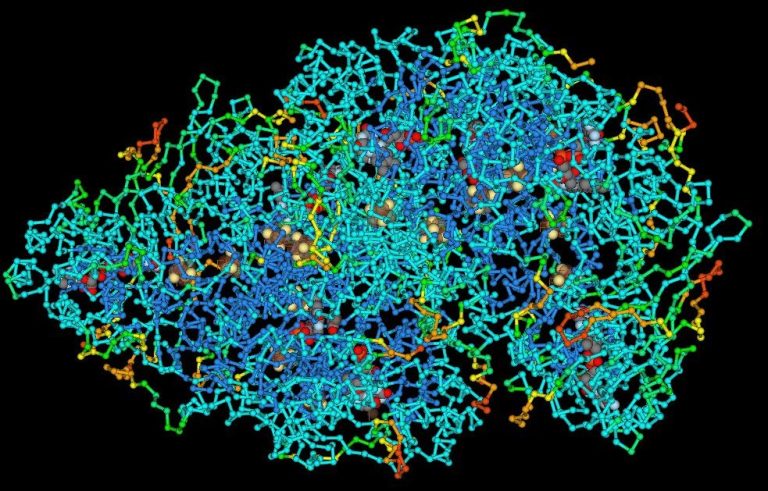
PROTEINS are the
Building-blocks of all cells
Cells are made by molecules called proteins.
Not only that, but pretty much every chemical reaction within cells would not proceed without the help of proteins. Needless to say, there would be no cells, and therefore no organisms, without proteins. However, proteins are large molecules with complex and very precise 3D molecular structures. The question is, can proteins be made by any natural process?

Physics and Chemistry
CANNOT MAKE PROTEINS
Proteins are molecules, but cellular proteins cannot be made by any chemistry or law of physics.
The molecular structure of proteins is so complex and specific that proteins need information for their construction. This information is not known by physics and chemistry. There is a chasm between physics and chemistry and proteins. Cells and organisms and cells shouldn't exist according to the laws of physics.

The image of the Holy Trinity
MAKES PROTEINS
The image of the Holy Trinity is what makes proteins within cells.
Not only does the image of the Holy Trinity contain the information to make cellular proteins, it also has the means to convert this information into actual proteins. Put simply, it constructs proteins. Clearly, the role of the image is neither ornamental nor insignificant in any way. Nor does it work instead of physics, rather the image bridges the chasm by working in addition to the laws of physics.
The image of the Holy Trinity
IN DETAIL
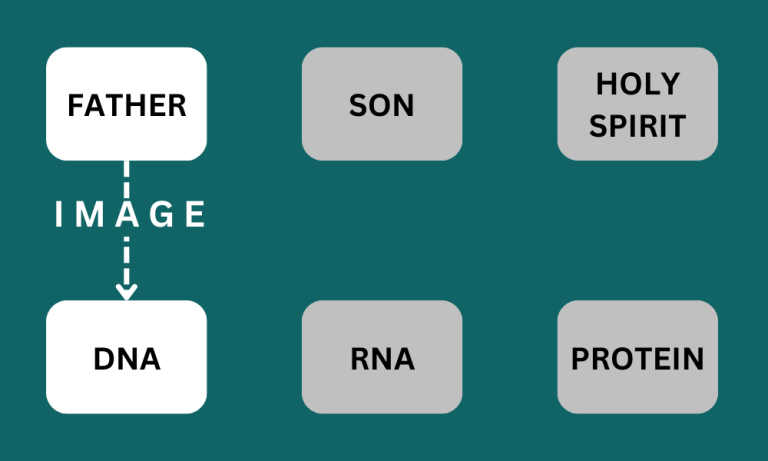
Father
DNA
The Father is the source of the divine nature. He does not receive the divine nature, rather he supplies the Son and the Holy Spirit with their divine nature.
DNA is the source of genetic information within the cell. DNA does not receive genetic information from RNA and protein, rather DNA supplies them with genetic information.
IMAGE: ✅

Son
RNA
The Son is the mediator in the Trinity: he receives everything from the Father, but he also communicates the divine nature to the Holy Spirit.
RNA is the mediator between DNA and proteins since genetic information is expressed in different ways in DNA and proteins. This allows genetic information to flow from DNA, through RNA, into proteins.
IMAGE: ✅

Holy Spirit
PROTEIN
The Holy Spirit does not communicate the divine nature. Once the divine nature reaches the Holy Spirit, it doesn't go any further.
Proteins do not communicate genetic information. Once genetic information reaches proteins, it doesn't go any further. This is known as the Central Dogma of molecular biology.
IMAGE: ✅
The image
IN MORE DETAIL
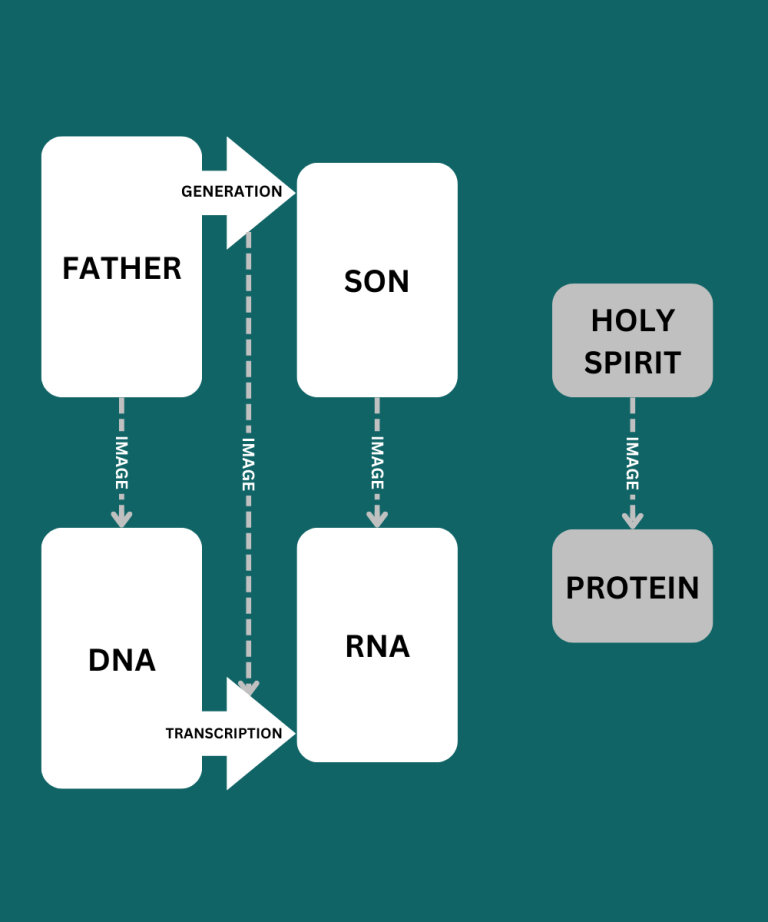
Generation
TRANSCRIPTION
The Father communicates the divine nature to the Son. This is known as generation because the Father actually generates the Son: the Father is the origin of the Son.
Genetic information is communicated from DNA to RNA. Biochemistry calls this transcription because genetic information is not merely transferred to RNA, RNA is actually produced. Transcription is the molecular image of generation in the Trinity. Another name for the Son is "Word" (John 1:1), which means the Son's generation could also be called "transcription".
IMAGE: ✅

Spiration
TRANSLATION
The Holy Spirit is not generated like the the Son, but is rather spirated from the Father and the Son. The Father communicates the divine nature through the Son, to the Holy Spirit.
What would the molecular image of spiration look like? Proteins are not produced in the same way as RNA. Both DNA and RNA produce proteins in a process known as translation. Genetic information is communicated from DNA through RNA and finally into proteins. This exactly corresponds to the origin of the origin of the Holy Spirit - translation is the molecular image of spiration.
IMAGE: ✅
The image
IN EVEN MORE DETAIL
Loopy Holy Spirit
LOOPY PROTEINS
All three persons always work together, as in spiration where the Father and the Son give rise to the Holy Spirit. The same goes for the generation of the Son from the Father. But where is the Holy Spirit? And what role could the Holy Spirit play since the Holy Spirit does not communicate the divine nature? The Holy Spirit is the basis of the Son's generation - the Father communicates the divine nature to the Son within the Holy Spirit. Since the Holy Spirit is the end of the Trinity, the Holy Spirit loops back to be also the centre of the Trinity.
There is no contradiction here - the Holy Spirit is not producing itself. The Holy Spirit can loop back because there is no time in the Trinity - everything happens simultaneously. This is not the case for DNA, RNA and protein, which of course do exist in time. Consequently, this is where we would expect the image of the Holy Trinity to break down. But it doesn't. During transcription, RNA is produced within large enzymes or proteins called RNA polymerase. This is a well-known chicken-and-egg paradox within biology, since it means the production of proteins requires proteins to exist in the first place. However, the paradox is now solved: proteins are the molecular image of the Holy Spirit. That's the reason why proteins loop-back on themselves.
IMAGE: ✅

THE CENTRAL DOGMA
OF MOLECULAR BIOLOGY
"It is remarkable that one can formulate principles such as the sequence hypothesis and the Central Dogma, which explain many striking facts and yet for which proof is completely lacking. This gap between theory and experiment is a great stimulus to the imagination"
Francis Crick
On Protein Synthesis (1958)
Unlike physics, biology does not have laws. But if biology did, there is no question that the Central Dogma of molecular biology would be a law.
The first thing that hits you about the Central Dogma is its name: dogmas don't exist in science. Science has hypotheses, theories, principles and laws, but not dogmas. Dogma is a theological concept meaning an irrefutable truth. But everything can be questioned in science, the same is true for the Central Dogma according to Francis Crick who discovered it in 1958. Crick didn't intend the Central Dogma to be understood in a religious sense whatsoever, after all, Crick was a devout atheist.
Now, imagine if the Central Dogma was actually the image of the Holy Trinity.
The Holy Trinity is the central dogma of Christianity since every other dogma in Christianity flows from the Trinity. This would mean the Central Dogma of molecular biology is the image of the central dogma of Christianity. What are the chances of that! And the Central Dogma would be more than a law - it really would be a dogma. Well, guess what? You guessed it. What biology has been calling the Central Dogma of molecular biology for decades, is actually the image of the of the Holy Trinity in the cell. Human beings can re-write textbooks, but only God can re-write them without actually changing the words.
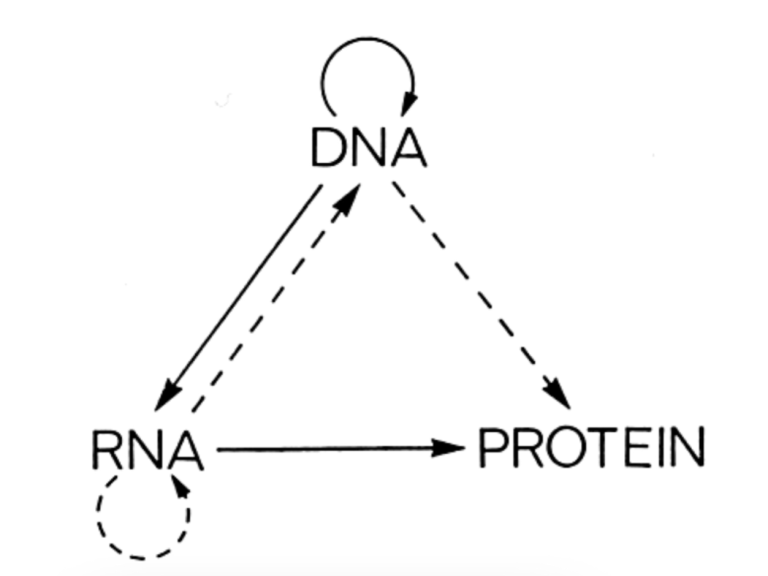

The Central Dogma
OF MOLECULAR BIOLOGY
What exactly is the Central Dogma of molecular biology?
The Central Dogma describes how DNA, RNA and protein communicate genetic information. Whereas DNA and RNA communicate genetic information, proteins do not. Crick put it this way: "once information flows into proteins, it doesn't get out again".

The Central Dogma
OF CHRISTIANITY (the Holy Trinity)
It is fair to say that the Central Dogma has always been a source of great mystery to the biological community.
But the reason is effortlessly explained by the Holy Trinity: proteins are the molecular image of the Holy Spirit. Therefore, proteins do not communicate genetic information in the cell, because the Holy Spirit does not communicate the divine nature in the Trinity.
THREE Divine Persons
THREE Informational Molecules
There are three Persons in the Trinity and there are three informational macromolecules: DNA, RNA and protein. This is no coincidence. Contrary to the widespread view, there is reason why there three divine persons, and there is also a reason why there are only three informational molecules. And these reasons are exactly the same.

Three for the SAME REASON
Divine persons are produced by the communication of the divine nature.
Generation produces the Son and spiration produces the Holy Spirit. Now, since all communication stops with the Holy Spirit, no more Persons can be produced. This leaves the Father, Son and Holy Spirit. That is, exactly three Persons in the Trinity, no more, no less.
Like the Trinity, informational macromolecules are produced by communication (of genetic information).
Transcription produces RNA and translation produces proteins. Crucially, just like in the Trinity, the communication of genetic information also ceases with the third informational macromolecule: protein (see Central Dogma). This leaves exactly three informational macromolecules, no more and no less: DNA, RNA and protein.
Points to Note
The image of the Holy Trinity is
NOT A COMPUTER NETWORK
Computer networks and DNA, RNA and protein both communicate information. Electronic information and genetic information are also the same type, they are both digital in nature. However, the Holy Trinity did not imprint a computer network in the natural world.

A mirage of the Holy Trinity.
DNA, RNA and protein is crucially different from a computer network for the following reason: computers cannot make themselves, rather they need to be constructed by human beings. In contrast, DNA, RNA and protein produce themselves. Computer networks merely transfer electronic information from one place to another, therefore, information remains the same. Whereas DNA, RNA and protein do not merely transfer genetic information, they physically realise what they communicate, information doesn't remain as information, it is transformed into matter.
No matter how powerful computers become, they will never be able to do what DNA, RNA and protein can do because electronic information is essentially separate from the underlying matter of the network. Put simply, computers deal with abstract information, or a "virtual reality", whereas DNA, RNA and protein deal directly with material reality. Nor can we make the image of the Holy Trinity ourselves by simply connecting three computers together, this is nothing more than a mirage of the Holy Trinity.
The image of the Holy Trinity is QUASI-MIRACULOUS
The image of the Holy Trinity is the result of divine intervention. However, it is not a miracle in the conventional sense since it does not violate or suspend any laws of physics. The image is a miracle, yet it is not a miracle, it quasi-miraculous.

The existence of the Holy Trinity is now
SCIENTIFICALLY PROVEN
The only reasonable explanation for why DNA, RNA and protein
is is all very well you might say, but we can only really begin to take the image of the Holy Trinity seriously once we know the Holy Trinity actually exists. But how do we know the Holy Trinity even exists? Simple: the image itself is scientific proof for the existence of the Holy Trinity.
If we deny the existence of the Holy Trinity, we end up with a much bigger problem: how on Earth did DNA, RNA and protein come to have the same structure as the God of Christianity? The simplest and most reasonable explanation of course is that DNA, RNA and protein have the same structure as the Trinity because the Trinity was the origin of
bear a detailed resemblance to the Trinity. What's more, they do not contradict the Trinity in any way. The only reasonable way this correspondence can be explained is if the Holy Trinity close , not to mention without any contradictions, is if it was actually and no contradiction re is This is no God delusion. The Holy Trinity is in science...No special dispensations have to be made, the Holy Trinity plays by the same rules as modern science. The image of the Holy Trinity is observable, testable and real. The Holy Trinity is as real as DNA. To deny the existence of the Trinity is as irrational as denying the existence of DNA,

Dawkins was close!
"But of course any God capable of intelligently designing something as complex as the DNA/protein replicating machine must have been at least as complex and organized as that machine itself..."
Richard Dawkins
The Blind Watchmaker (1986), p. 141

What do you think?
CASE STUDY
The Origin of the
DOUBLE HELIX
Have you ever wondered how DNA got its famous double helix structure? Mainstream science of course assumes it was by some unknown natural process. But the two strands of the double helix are not identical. Nor does each strand contain half the total amount of genetic information. Rather, the two strands are complementary information. Like mirror images of one another, except the information is not made from light but because genetic information itself is complementary in nature.
What is the mirror image of a mirror image? The answer is: the original. When DNA is copied or replicated to make new DNA, the complementary strand is used. The opposite or complementary information results in the original information. The point is, genetic information does not need to be communicated to DNA from outside, DNA is the source of its own genetic information. The double helix is a molecular image of the most mysterious aspect of the Holy Trinity: the Father's self-origin.

The double helix structure of DNA mirrors the Father's self-origin.
SON
IMAGE
RNA

RNA is the molecular image of the Son.
Son
Image of the Father
The Son is just like the Father, he is divine and he communicates the divine nature. But the Son is not the Father because the Son has one crucial difference - the Son is not the origin of himself like the Father. Instead, the Son receives his entire being from the Father. The Son is identical yet different from the Father, or the "image" of the Father (Colossians 1:15).
RNA
Image of DNA
RNA is essentially identical to DNA chemically speaking, since RNA is a nucleic acid just like DNA. This means RNA can store and communicate genetic information just like DNA. But RNA contains an obvious structural difference: it is not a double helix, it only contains one strand, not two swirling strands. RNA is chemically and informationally the same as DNA, but structurally different. RNA is the molecular "image" of DNA.
RNA
Molecular Image of the Son
What would a molecular image of the Son be like? The answer is: a molecular image of DNA, since DNA is the molecular image of the Father. This is precisely what RNA is: the molecular image of DNA. Just as the Father is the origin of the Son, so DNA is the origin of RNA. What's more, RNA is produced in the same way that the Son is produced in the Trinity, namely, communication. Just as the Father communicates the divine nature to the Son, so DNA communicates genetic information to RNA. Biology calls RNA the molecular "cousin" of DNA. However, this is because RNA is truly the molecular image of the Son.
RNA: Mediator
(Just like the Son)
The Father always works through the Son. Since the Father is also the origin of the Holy Spirit, this means the Father communicates the divine nature to the Holy Spirit through the Son. The Son is therefore the mediator between the Father and the Holy Spirit. If RNA really is the molecular image of the Son, then RNA should be a mediator between DNA and proteins. Indeed, this is exactly what we find. DNA does not, indeed, cannot communicate genetic information directly to proteins because the information in proteins is expressed in a different form (amino acids rather than nucleic acids). DNA and proteins use two different languages which are connected by the genetic code. In order for information to flow from DNA into proteins, what is needed is a mediator who "knows" the genetic code. This mediator which acts in-between DNA and proteins, is RNA.
HOLY SPIRIT
IMAGE
PROTEIN

The Holy Spirit
Does not communicate
What makes the Holy Spirit different from the Father and the Son, is that the Holy Spirit does not communicate the divine nature. This is why the Holy Spirit never utters a single word anywhere in the Bible. And why the first disciples of Christ were oblivious to the Holy Spirit: "We have never even heard of the Holy Spirit" (Acts 19:2).
The Holy Spirit doesn't communicate because he is the end-point of all communication within the Trinity. Whereas the Father is an infinite source of divinity, the Holy Spirit is an infinite sink in which the divine nature flows into, but never leaves. More specifically, the divine nature flows from the Father, through the Son, and finally into the Holy Spirit. Since it is the Son who communicates the divine nature directly to the Holy Spirit, St Irenaeus of Lyon gave one of the most beautiful definitions of the Holy Spirit in the 2nd Century: "Communicatio Christi", the communication of Christ.
Proteins
Do not communicate
By a simple process of elimination, the only remaining informational macromolecule which can be the molecular image of the Holy Spirit, is protein. However, we can't simply assume this fact. To be the image of the Holy Spirit, there is one condition which proteins simply must satisfy: they must not communicate genetic information. Because the Holy Spirit does not communicate the divine nature in the Trinity.
This is precisely what we find. Genetic information flows into proteins, but it is not communicated any further. Like the Holy Spirit, proteins are the end-point of communication. What's more, the flow of genetic information into proteins follows exactly the same pattern as the flow of the divine nature into the Holy Spirit. That is, from DNA through RNA, and into proteins. A suite of RNA molecules communicate genetic information directly to proteins. In other words, proteins are the direct result of the communication of RNA. Or, more succinctly, "Communicatio RNA".
THE IMAGE
IN EVEN MORE DETAIL
GENERATION
IMAGE
TRANSCRIPTION

Transcription, or the production of RNA from DNA, mirrors the generation or the origin of the Son from the Father.
GENERATION
Origin of the Son
As God, the Holy Trinity has always existed. This does not mean the divine persons have no origin, rather they are the origin of each other. In the same vein, communication in the Trinity is not merely a transfer of the divine nature - the divine nature is not being passed around like a glorified game of pass-the-parcel. Nor are the divine persons merely having a conversation.
The divine nature can only be communicated in its entirety, and when it is, what results is another divine person - distinct from all others. The Father communicates the divine nature to the Son and this is called generation, because the Father is actually the origin of the Son. Hence their names. There is no end to the Son's generation because there is no end (or beginning) to the divine nature communicated to the Son.
TRANSCRIPTION
Production of RNA
In ordinary communication, for example, between computers or people, or even quantum communication, the sender and the receiver already exist before the communication takes place. This seems obvious, after all, how can there be communication if there is nothing to perform the communication in the first place! However, this is not what happens during the communication of genetic information, since the receiver doesn't exist.
How is this possible? Because the communication of genetic information produces the receiver. When genetic information is communicated from DNA to RNA, a brand new RNA molecule is produced. Information becomes matter, which is why it is called transcription. The transcription of RNA is the molecular image of the Son's generation in the Trinity. We shouldn't be fooled by the different choice of language employed by Christian theology and biochemistry: another name for the Son is the divine "Word" (John 1:1). Generation of the Son is therefore the origin of the divine Word. So, generation could equally be called transcription.
SPIRATION
IMAGE
TRANSLATION
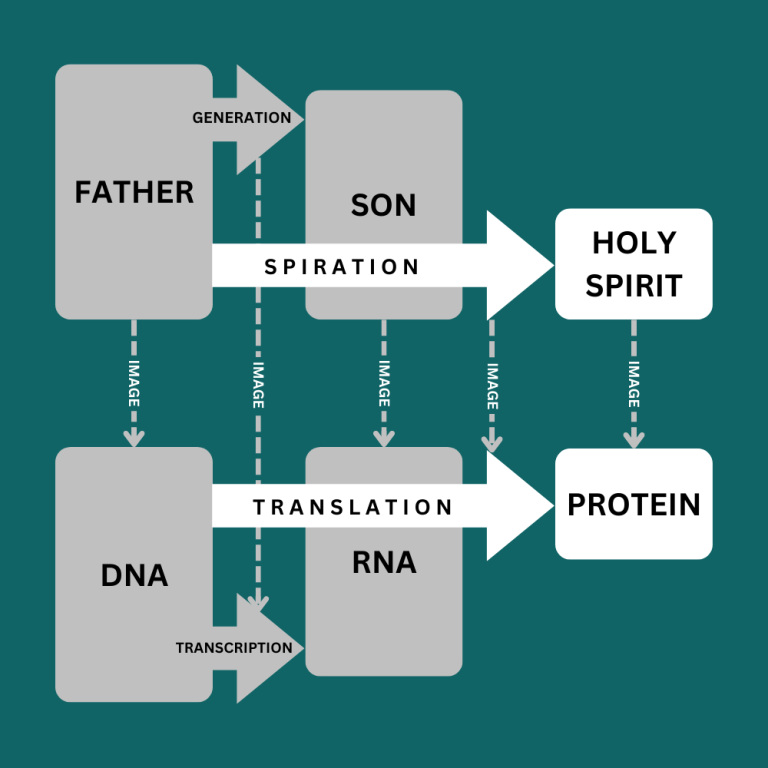
Lorem ipsum dolor sit amet, consectetur adipiscing elit. Nulla euismod condimentum felis vitae efficitur. Sed vel dictum quam, at blandit leo.
SPIRATION
Origin of the Holy Spirit
(From the Father and the Son)
Like the Son, the Holy Spirit also has an origin. However, the origin of the Holy Spirit is different from that of the Son.
The Father alone is the origin of the Son because only the Father communicates the divine nature to the Son. But in the case of the Holy Spirit, both the Father and the Son communicate the divine nature to the Holy Spirit.
The divine nature is absolutely indivisible, so it is not split between the Father and the Son. The Father communicates the divine nature to the Son who, in turn communicates it to the Holy Spirit.
So, the Father and the Son are indirectly and directly the origin of the Holy Spirit respectively, but they both work together inseparably as one to be the origin of the Holy Spirit.
Which is why this is called spiration since this (old word) means breathing, and the Father and the Son act simultaneously like two lungs to breathe or exhale the Holy Spirit.
TRANSLATION
Production of Proteins
(From DNA and RNA)
If the production of proteins - or protein synthesis - is the molecular image of spiration, then we expect it to be different from the production of RNA. That is, not transcription.
We would expect genetic information to be communicated to proteins not just from DNA - as is the case for the production of RNA - but from both DNA and RNA instead.
More specifically, we should expect to see genetic information communicated from DNA through RNA, and finally into proteins.
This is what we should find if protein production is the image of the Holy Spirit's origin in the Trinity. Indeed, this is precisely what we find.
Biochemistry calls it translation because the genetic information which forms proteins, and which is originally stored in DNA, is communicated to RNA, where the information is converted (translated) into the form which makes proteins, using the genetic code.
Another Difference Between
GENERATION AND SPIRATION:
Communication of
SPIRITUAL APPARATUS
the divine nature is communicated to the Holy Spirit. However, to be a distinct person in his own right (specifically not another Son), the origin of the Holy Spirit is different from that of the Son. So, whereas the Son is generated from the Father, the Holy Spirit must originate in some other way.
Since the Father is the source of all divinity in the Trinity, the Father is still the origin of the Holy Spirit, but unlike the Son, the Father does not communicate the divine nature directly to the Holy Spirit. Instead, the Father communicates through the Son. The Son is the one in direct contact with the Holy Spirit and who communicates the divine nature directly to the Holy Spirit. This means the Father communicates not one, but two things, to the Son: the divine nature and the power to communicate the divine nature. Without this power, or spiritual apparatus, the Son would not be able to communicate the divine nature to the
The Father is the origin of the Holy Spirit, since the Father is the source of all divinity in the Trinity.
The Holy Spirit is clearly different from the Father, but also the Son. This means the Holy Spirit must originate from the Father in a different way to that of the Son. Put simply, the Holy Spirit is not generated like the Son: the Father does not communicate the divine nature directly to the Holy Spirit. Instead, the Father communicates through the Son.
The Son is the one in direct contact with the Holy Spirit, who directly communicates the divine nature to the Holy Spirit. But, the Son is not the source of the divine nature. The Son receives the divine nature from the Father, which he then communicates to the Holy Spirit. That is not all. In order to be able to communicate the divine nature, the Son must have the power or spiritual apparatus to communicate. The Son receives this power from the Father in addition to the divine nature. The origin of the Holy Spirit is called spiration because both the Father and the Son work together to "breathe" the Holy Spirit, like a pair of lungs.
Another Difference Between
TRANSCRIPTION AND TRANSLATION:
Communication of
MOLECULAR MACHINERY
DNA is the source of the genetic information which makes proteins. However, genetic information in DNA cannot be directly communicated into proteins since proteins are not nucleic acids like RNA where there is a one-to-one correspondence with the genetic information stored in DNA. Proteins are made from amino acids which are a translated form of genetic information. To produce proteins it is necessary to take the information stored in DNA and subsequently translate it into the corresponding amino acid sequences. The production of proteins therefore requires contributions from two distinct entities: DNA and the translation apparatus, which is RNA. Just as the Father and the Son are the origin of the Holy Spirit, DNA and RNA work together to produce proteins.
To make any given protein, it is necessary to know the specific amino acid sequence. This information is transcribed from DNA into messenger RNA (mRNA). This is not the only RNA, there is also ribosomal RNA (rRNA) and transfer RNA (tRNA). These do not contain information to make proteins, rather rRNA and tRNA comprise the molecular machinery which actually makes proteins by collecting the correct amino acids (tRNA) and bonding them together in the right order (rRNA).
This directly corresponds with the Father communicating the spiritual apparatus for communication to the Son, as well as the divine nature. Translation, or the production of proteins is undoubtedly the molecular image of spiration or the origin of the Holy Spirit.
Proteins are also produced by the communication of genetic information. If this is to be the image of spiration, then it must be different from transcription. Which it is, since it is called translation. Is this the image of For this to be the image of The production of proteins, or protein synthesis, is called translation. The first thing we notice about this is that it is not transcription. This is precisely what
is that it has a different name . here is no equivalent to Trinitarian generation in everyday communication. Ordinary communication is merely the transfer of information - nothing is actually produced. When people talk or computers send data, for example, only abstract information is transferred from one place to another, what is communicated is not physically realised. The exception to this is inside living cells. When DNA communicates genetic information, another molecule comes into existence: RNA. Biochemistry calls this process "transcription" since the genetic "words" stored in DNA (another term used in biochemistry) are re-written as RNA molecules. The transcription of RNA directly corresponds to the generation of the Son. In fact, the Son's generation is a transcription, after all, the Son is the "Word" (John 1:1) spoken by the Father.
There exist millions of different molecules. But out of all these molecules, there are only three which exist specifically to communicate information, and they exist within every cell. They are called DNA, RNA and protein. It doesn't take much to realise that DNA and RNA have similar names. This is just like the names of the Father and the Son in the Trinity.
What do we find in the Trinity? The Holy Spirit does not continue the pattern of names set by the Father and the Son - the Holy Spirit is not the Holy Grandson! Rather, the Holy Spirit has a different type of name. DNA, RNA and protein therefore have exactly the same pattern of names as the Father, Son and Holy Spirit. This correspondence is not a coincidence. DNA, RNA and protein are the image of the Holy Trinity, and it is even visible in their names.
The communication of the divine nature from the Father to the Son is specifically called generation because the Father generates the Son. That is to say, the Father continuously or eternally produces the Son. When the Father communicates to the Son, the Father gives the entire divine nature to the Son (without losing it himself). Hence why the Son is produced. The Father is not merely transferring the divine nature to the Son like a glorified game of pass-the-parcel. The Father is the origin of the Son. Indeed, this is the mechanism by which God created the universe. God did not fabricate the universe piece by piece, God spoke everything into existence (cf. Genesis 1).
There is no equivalent to Trinitarian generation in everyday communication. Ordinary communication is merely the transfer of information - nothing is actually produced. When people talk or computers send data, for example, only abstract information is transferred from one place to another, what is communicated is not physically realised. The exception to this is inside living cells. When DNA communicates genetic information, another molecule comes into existence: RNA. Biochemistry calls this process "transcription" since the genetic "words" stored in DNA (another term used in biochemistry) are re-written as RNA molecules. The transcription of RNA directly corresponds to the generation of the Son. In fact, the Son's generation is a transcription, after all, the Son is the "Word" (John 1:1) spoken by the Father.
© 2025 TRINITY in BIOLOGY
We need your consent to load the translations
We use a third-party service to translate the website content that may collect data about your activity. Please review the details in the privacy policy and accept the service to view the translations.
